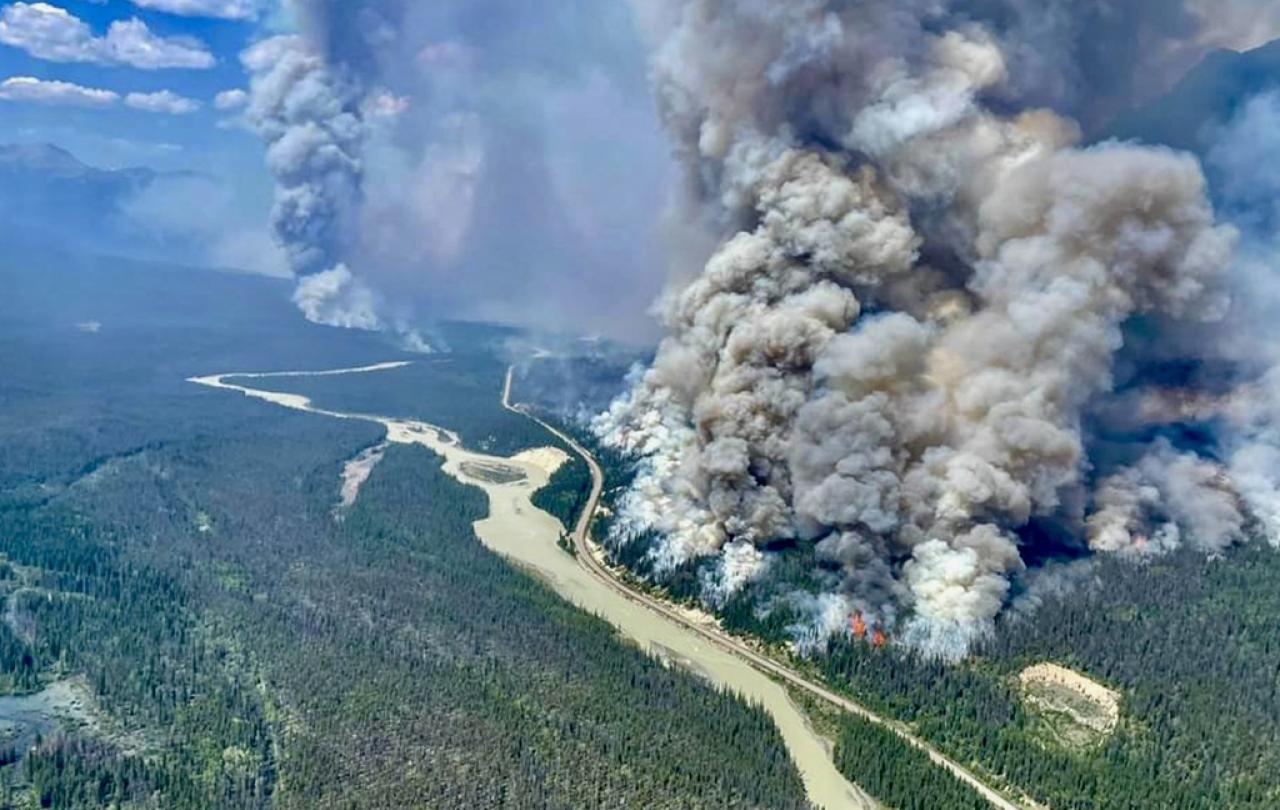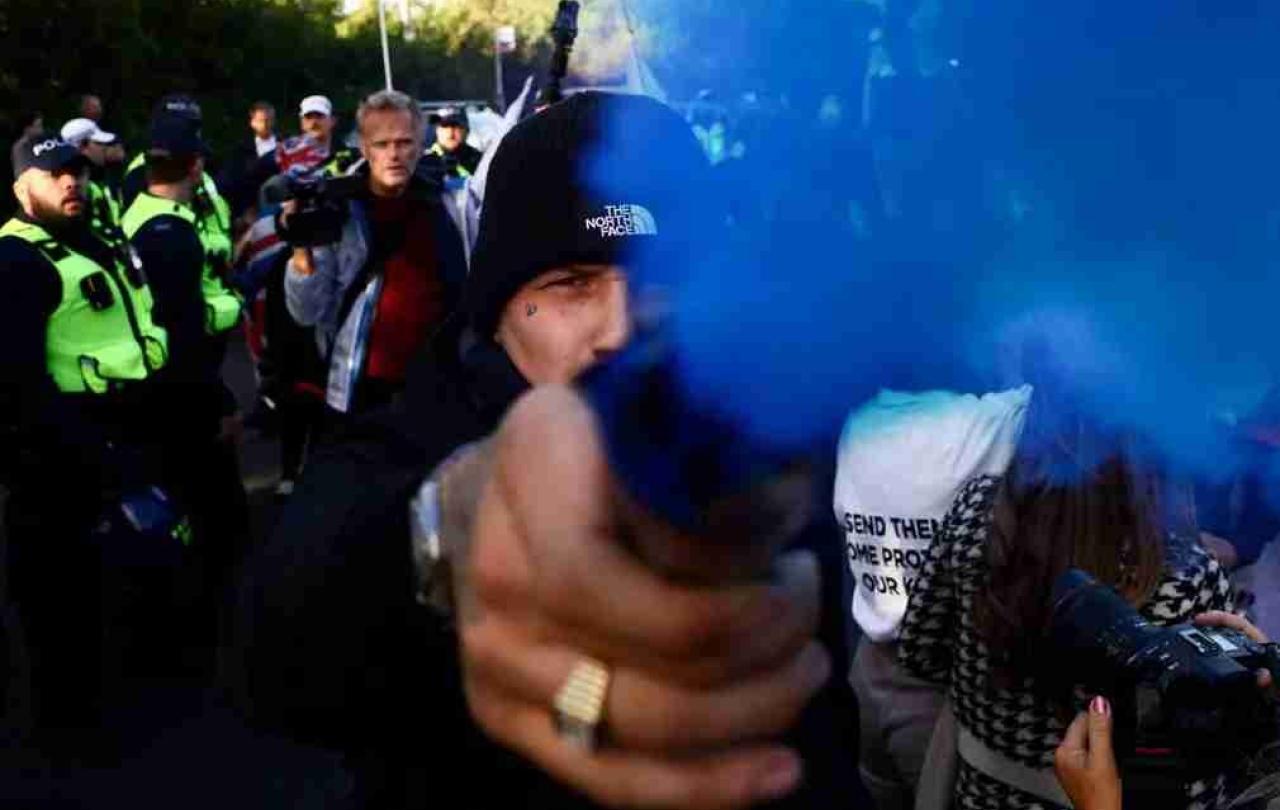
In July 2024, wildfires blazed across large swathes of Alberta, engulfing much of the town of Jasper. As the smoke drifted to the City of Edmonton, air quality worsened considerably, reaching 10+ out of 10, or “very high risk,” on the air quality health index.
The smoke confined much of the city of one million inhabitants to their homes – keeping stoves, television sets and other electrical appliances off to deal with the mid-thirties Celsius heat. Many wore masks when daring to venture outside. Scenes were, as in the past, apocalyptic – imagine the movie Bladerunner 2049.
In 2016, the first major fire occurred in Fort McMurray, which led to a successful evacuation of 90,000 residents with photographs depicting what looked like hell on earth. This fire, covered by the international press, was at the time a one-off. It has since become the norm during Canadian summers.
The fires are emblematic of the state of Canada.
Now, metaphorical fires of all sorts – breaking of the healthcare system, surging housing costs, immigration without a plan, and decreasing civility in political debate – are spreading across Canada.
It is noteworthy to witness just how rapidly Canada’s situation has degraded. It is a testament to the quickness – not unlike the spreading of a forest fire, ignited by an errant cigarette – with which a small group of individuals within a government can inflict lasting damage on a country.
Indeed, the last decade for Canada has represented a backward turn. It is a regression from earlier domestic and international success, in which many across the world looked to Canada as a beacon of hope. Our international standing has diminished noticeably.
This unexpected looking back to better times is well captured in the song “The Boys of Summer.” I often listened to The Ataris cover of the Don Henley classic when playing travel baseball across Canada and the US in my teens.
The narrator reflects nostalgically on a summer romance. What was once present is now gone:
“Don’t look back, you can never look back/I thought I knew what love was, what did I know?/ Those days are gone forever/I should just let them go but…”.
The story is much the same for Canada. What appeared so promising as recently as the early 2010s – the country on the rise economically and with a solid reputation internationally – has given way to decline and crumbling of vital social services. For example, healthcare median appointment waiting times now average 27.7 weeks (about 6 and a half months), though higher in the provinces of the Maritimes and Alberta.
Internationally, Canada no longer enjoys a privileged relationship with the United States. The relationship will become even more fraught should former President Trump re-assume the role of President while Prime Minister Justin Trudeau is in power.
Looking to China, Canada suggests the need for “dialogue,” a foreign policy nevertheless ten years out-of-date, and despite Canada serving as China’s international punching-bag.
We have become afraid to not be invited, rather than to step forward with courage.
We are, of course, in a darkening period in world history. Evil appears to be more strongly at work in the world now than in recent memory.
The coronavirus pandemic was a turning-point, in which American and Chinese relations began to fracture. This was followed two years later by the Russian invasion of Ukraine and close to two years after this, the 7 October massacre of Jews by the terrorist group Hamas.
In the United Kingdom, the murder of three girls in Southport has given way to nationwide riots, spreading through social media and its network effects.
The dividing lines between identity-based groups domestically, and alliances internationally, are becoming clearer and more rigid. This is the trend since the pandemic crisis. Earlier tolerance of “grey” areas of difference is giving way to “black and white” division between nations and groups within them.
Canada is therefore no exception to the crises facing democracies in the political West. Yet Canada’s failures are notable, given the shining light of political moderation, of government effectiveness, and of international collaboration that Canada historically is.
Most notable and concerning within Canada is the lack of courage among political leadership. Canadian leadership fails to speak and act boldly domestically or internationally. Prime Minister Trudeau reportedly avoids cabinet meetings and one-on-one meetings with ministers, hiding whenever problems emerge. This is the opposite of courage.
Courage, a distinctive Canadian virtue so well proven in WWI Battles of Vimy Ridge, Passchendaele and The Somme, or the Battle of the Atlantic in WWII, is in short supply. Yet, if there was ever a distinctive Canadian quality, it is courage, often in times of crisis.
In my time abroad, I have been struck by an increasing Canadian refrain on just wanting to “be at the table,” but without considering what our contributions at the table will be. We have become afraid to not be invited, rather than to step forward with courage.
What are individuals to do when they see their country falling apart? And what are they to do when looking at their country’s regression from some distance, as members of the global Canadian diaspora?
A compelling example is given by the philosopher Robert Adams in his retelling of the story of Dietrich Bonhoeffer. Bonhoeffer, a German theologian, left for New York on 7 July 1939, where he was received by American friends providing safety from Nazism.
Yet, within days Bonhoeffer found his time in New York “almost unbearable,” noting that “If trouble comes now, I shall go right back to Germany. I cannot stay out here alone; I am quite clear about this, for after all, over there is where I live.”
Bonhoeffer later reflects “I have made a mistake in coming to America. I must live through this difficult period of our national history with the Christian people of Germany. I will have no right to participate in the reconstruction of Christian life in Germany after the war if I do not share the trials of this time with my people.”
Adams uses Bonhoeffer as an example of vocation, highlighting belonging, caring and participation in social processes as key elements of a vocation. Returning to Germany was not necessarily what was best for Bonhoeffer (he would later die in the waning period of the war in Germany, while he would have carved out a prestigious academic career in America). But Adams notes that Bonhoeffer would have felt it wrong had he not returned.
In short, Bonhoeffer belonged with his democratically minded neighbours in Germany. He cared about the restoration of his country. And he knew that he must participate in the fight against evil enveloping Europe.
It often takes leaving your own country to understand it more clearly. I have learned during my time abroad that Canadians are understated and yet highly competent, open-minded and hopeful.
Canada has a powerful diaspora, whose global influence is well captured by former Globe & Mail newspaper editor John Stackhouse in his book Planet Canada. Years ago, the “Canadian Mafia” was the tongue-in-cheek name given to Canadians who simultaneously led multiple major British institutions such as the Bank of England, University of Cambridge, Royal Mail, Wimbledon, Associated British Ports, UK National Lottery, Heathrow Airport, and Canary Wharf, not to mention leading the BBC’s International reporting.
In recent years, many age-mates and friends served in leading roles in top think tanks and UK institutions such as No 10 Downing Street, helping to design and implement UK technology innovation policy, or crafting health and social care policy while helping spearhead the UK vaccination campaign to hard-to-reach minority groups.
The senior-level of Canadian leadership in the UK was followed by many early or mid-career Canadians serving in influential UK leadership roles.
But just as Bonhoeffer returned to Germany, or as Israelis returned immediately from jobs in technology, finance, academia and other sectors in America and the UK to serve their country in the fight against terrorism, now is the time for many within the Canadian diaspora to return to Canada.
Such is the damage that has been inflicted on the country over the last decade, and the future plight, should Canada’s brightest not dedicate themselves fully to the Canadian cause as part of defending the long-term good in the wider world.
It often takes leaving your own country to understand it more clearly. I have learned during my time abroad that Canadians are understated and yet highly competent, open-minded and hopeful. There is a palpable energy and desire to contribute meaningfully – not apathetically – among Canada’s Gen Zers.
Canada’s young people balance their own diverse ethnic origins with an abiding love of Canada. They want to make Canada better.
Canadians must not only show up at the table but contribute – with confidence – when at the table. The focus must be to participate, and then win the prize.
Just as the narrator ends on a high in “The Boys of Summer” – saying “I can tell you, my love for you will still be strong/After the boys of summer have gone” – there remains considerable hope for Canada.
But this hope must translate into critically minded participation in Canadian life. This critical spirit toward leadership and institutions is one part of courageous, confident and sometimes even assertive action in the world.
On assertiveness, Canada can learn from its ally Israel. In his recent speech to U.S. Congress, Israeli Prime Minister Benjamin Netanyahu spoke boldly on behalf of the rising scourge of antisemitism facing the Jewish people. He highlighted the nefarious influence of totalitarianism.
Most importantly, he highlighted our shared democratic struggle. Indeed, Israel’s success in the fight against evil in the form of totalitarianism is a precursor to the success of other democracies such as the United States, Canada and the UK in the same fight: “Our enemies are your enemy, our fight is your fight, and our victory will be your victory.”
Whatever one thinks of Netanyahu, he stood up forcefully for his nation and for the Jewish people in the face of evil seeking to undo the values underpinning our democracies.
While likely to be more moderate in tone, Canadians must nevertheless participate boldly in the world, regaining our characteristic courage.
In reflecting on his tenacious service, St Paul asks “Do you know that in a race the runners all compete, but only one receives the prize? Run in such a way that you may win it.”
Canadians must not only show up at the table but contribute – with confidence – when at the table. The focus must be to participate, and then win the prize.
Canadian renewal is possible, but this demands that Canadians abroad return home – like Bonhoeffer – bringing their experiences, learnings and networks acquired as members of the Canadian diaspora with them. Indeed, these help form the basis for courage.
This return is one key step in Canadians contributing to victory – along with British, American, French, German, Israeli and other allies – in the fight against darkness. We must light our lamps within the darkness, keeping awake at home in readiness to put out the fires coming our way from over the foothills.





